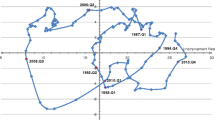Abstract
Due to unique institutional and technological factors, seasonal agricultural jobs are characterized by much higher risk of unemployment than similar permanent jobs. I estimate compensating differentials for risk of unemployment and compare those with unemployment insurance benefits provided by the government. I use two sets of estimators. First, I calculate parametric estimates with Heckman correction. Second, I compute three versions of a distribution-free semiparametric estimator which is robust to misspecification of the residual distribution. The main finding of the paper is that there exists a positive compensating differential of 15.5% of the average wage. This corresponds to an implicit replacement rate significantly larger than the typical unemployment benefit.
Similar content being viewed by others
References
Abowd, J., and O. Ashenfelter. (1981). “Anticipated Unemployment Temporary Layoffs and Compen-sating Wage Differentials,” In S. Rosen ed., Studies in Labor Markets. Chicago: University of Chicago Press.
Abowd, J., and O. Ashenfelter. (1984). “Compensating Wage and Earnings Differentials for Employer Determined Hours of Work,” Working Paper, University of Chicago.
Ahn, H., and J. L. Powell. (1993). “Semiparametric Estimation of Censored Selection Models with a Nonparametric Selection Mechanism,” Journal of Econometrics 58, 3-29.
Altonji, J. G., and C. R. Pierret. (1997). “Employer Learning and Statistical Discrimination.” Manuscript.
Biddle, J. E., and G. A. Zarkin. (1988). “Worker Preferences and Market Compensation for Job Risk,” The Review of Economics and Statistics 70, 660-667.
Bronars, S. (1983). “Compensating Wage Differentials and Layoff Risk in U.S. Manufacturing Industries,” PhD Dissertation, University of Chicago.
Bureau of Labor Statistics. (1994). “Contingent and Alternative Employment Arrangements.” Report 900.
Card, D. (1987). “Supply and Demand in the Labor Market.” Working Paper 228, Industrial Relation Section, Princeton University.
Chen, S. (1996). “Distribution-Free Estimation of the Random Coefficient Dummy Endogenous Variable Model.” Unpublished manuscript, Hong Kong University of Science and Technology.
Cosslett, S. R. (1981). “Distribution-Free Maximum Likelihood Estimator of the Binary Choice Model,” Econometrica 51, 765-782.
French, M. T., and D. L. Kendall. (1992). “The Value of Job Safety for Railroad Workers,” Journal of Risk and Uncertainty 5, 175-185.
Garen, J. (1988). “Compensating Wage Differentials and the endogeneity of job riskiness,” The Review of Economics and Statistics 70, 9-16.
Gunter, L. (1986), “Wage Determination for Regular Hired Farm Workers: An Empirical Analysis for Georgia,” Southern Journal of Agriculture Economics 18, 197-206.
Hamermesh, D. S., and J. R. Wolfe. (1990). “Compensating Differentials and the Duration of the Wage Loss,” Journal of Labor Economics 8 (1), 175-187.
Han, A. K. (1987). “Non-Parametric Analysis of a Generalized Regression Model: The Maximum Rank Correlation Estimator,” Journal of Econometrics 35, 303-316.
Hashida, E. (1995). “Three Essays on Agricultural Workers.” Doctoral Dissertation, Department of Agricultural and Resource Economics, University of California, Berkeley.
Hwang, H., W. R. Reed, and C. Hubbard. (1992). “Compensating Wage Differentials and Unobserved Productivity,” Journal of Political Economy 100 (4), 834-858.
Ise', S., and J. M. Perloff. (1995). “Legal Status and Earnings of Agricultural Workers,” American Journal of Agricultural Economics 77, 375-386.
Li, E. H. (1986). “Compensating Differentials for Cyclical and Noncyclical Unemployment: The Interaction Between Investors’ and Employees’ Risk Aversion,” Journal of Labor Economics 4 (21), 277-300.
Mines, R., S. Gabbard, and B. Boccalandro. (1991). “Findings from the National Agricultural Workers Survey NAWS 1990: A Demographic and Employment Profile of Perishable Crop Farm Workers.” Washington D.C.: U.S. Department of Labor, Office of the Assistant Secretary for Policy, Office of Program Economics, Research Report No. 1.
Moore, J. J. (1995). “Unions, Employment Risks and Market Provision of Employment Risk Differentials,” Journal of Risk and Uncertainty 10, 57-70.
Moretti, E., and J. M. Perloff (1999). “Minimum Wage Lowers Some Agricultural Wages.” Manuscript, University of California, Berkeley.
Murphy, Kevin, and Robert Topel. (1987). “Unemployment Risk and Earnings: Testing for Equalizing Wage Differences in the Labor Market.” In Lang and J. Leonard Unemployment and the Structure of Labor Market, New York: Blackwell.
Perloff, J. M. (1991). “The Impact of Wage Differentials on Choosing to Work in Agriculture,” American Journal of Agricultural Economics 73, 671-80.
Powell, J. L. (1989). “emiparametric Estimation of Censored Selection Models.” Unpublished manuscript, University of Wisconsin.
Powell, J. L., and T. M. Stoker. (1996). “Optimal Bandwidth Choice for Density-Weighted Averages,” Journal of Econometrics 75, 291-316.
Taylor, J. E. (1992). “Earnings and Mobility of Legal and Illegal Immigrant Workers in Agriculture,” American Journal of Agricultural Economics 74, 889-896.
Thaler, R., and S. Rosen. (1976). “The Value of Saving a Life: Evidence from the Labor Market.” In N. Terleckyz ed., Household Production and Consumption, NBER Studies in Income and Wealth, No.40. New York: Columbia University Press.
Topel, R. H. (1984). “Equilibrium Earnings, Turnover and Unemployment: New Evidence,” Journal of Labor Economics 2 (4), 500-522.
U.S. Department of Labor. (1991). “Findings from the National Survey of Agricultural Workers,” Office of Program Economics, Research Report No. 1.
U.S. Department of Labor. (1994a). “Migrant Farmworkers: Pursuing Security in an Unstable Labor Market.” Research Report No. 5.
U.S. Department of Labor. (1994b). “Comparison of State Unemployment Insurance Laws.” Comparison Revision No. 3.
Viscusi, W. K. (1978). “Wealth Effect and Earning Premium for Job Hazard.” The Review of Economics and Statistics 60 (3), 408-416.
Author information
Authors and Affiliations
Rights and permissions
About this article
Cite this article
Moretti, E. Do Wages Compensate for Risk of Unemployment? Parametric and Semiparametric Evidence from Seasonal Jobs. Journal of Risk and Uncertainty 20, 45–66 (2000). https://doi.org/10.1023/A:1007862603025
Issue Date:
DOI: https://doi.org/10.1023/A:1007862603025




